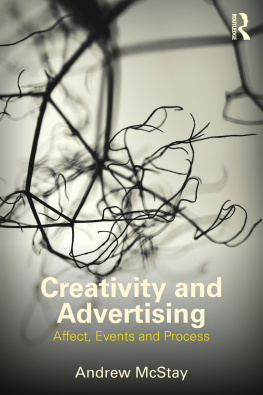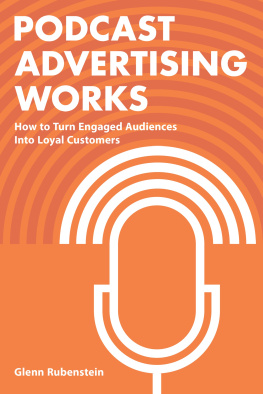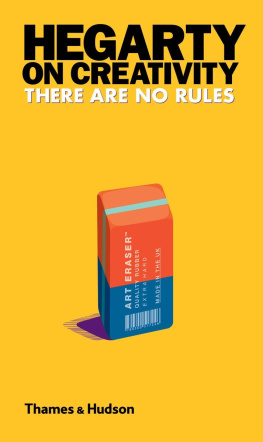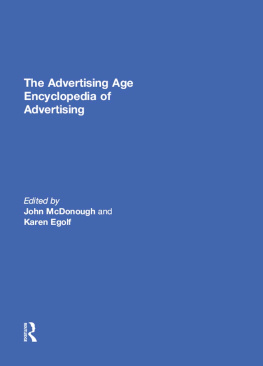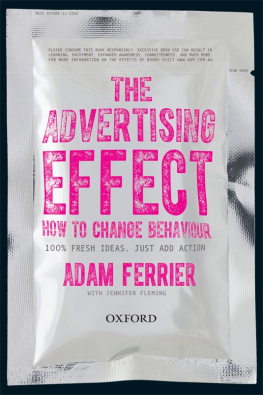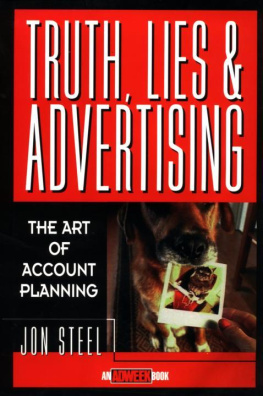Creativity and Advertising
Creativity and Advertising develops novel ways to theorise advertising and creativity. Arguing that combinatory accounts of advertising based on representation, textualism and reductionism are of limited value, Andrew McStay suggests that advertising and creativity are better recognised in terms of the event. Drawing on a diverse set of philosophical influences including Scotus, Spinoza, Vico, Kant, Schiller, James, Dewey, Schopenhauer, Whitehead, Bataille, Heidegger and Deleuze, the book posits a sensational, processbased, transgressive, lived and embodied approach to thinking about media, aesthetics, creativity and our interaction with advertising.
Elaborating an affective account of creativity, McStay assesses creative advertising from Coke, Evian, Google, Sony, Uniqlo and Volkswagen among others, and articulates the ways in which award-winning creative advertising may increasingly be read in terms of co-production, playfulness, ecological conceptions of media, improvisation, and immersion in fields and processes of corporeal affect.
Philosophically wide-ranging yet grounded in robust understanding of industry practices, the book will also be of use to scholars with an interest in aesthetics, art, design, media, performance, philosophy and those with a general interest in creativity.
Andrew McStay lectures at Bangor University and is author of Digital Advertising , The Mood of Information: A Critique of Online Behavioural Advertising and Deconstructing Privacy , the latter forthcoming in 2014.
Creativity and Advertising
Affect, events and process
Andrew McStay
First published 2013
by Routledge
2 Park Square, Milton Park, Abingdon, Oxon OX14 4RN
Simultaneously published in the USA and Canada by Routledge
711 Third Avenue, New York, NY 10017
Routledge is an imprint of the Taylor & Francis Group, an informa business
2013 Andrew McStay
The right of Andrew McStay to be identified as author of this work has been asserted by him in accordance with sections 77 and 78 of the Copyright, Designs and Patents Act 1988.
All rights reserved. No part of this book may be reprinted or reproduced or utilised in any form or by any electronic, mechanical, or other means, now known or hereafter invented, including photocopying and recording, or in any information storage or retrieval system, without permission in writing from the publishers.
Trademark notice : Product or corporate names may be trademarks or registered trademarks, and are used only for identification and explanation without intent to infringe.
British Library Cataloguing in Publication Data
A catalogue record for this book is available from the British Library
Library of Congress Cataloging in Publication Data
McStay, Andrew, 1975
Creativity and advertising: affect, events and process / Andrew McStay.
pages cm
Includes bibliographical references.
1. Advertising. 2. Creative ability. I. Title.
HF5821.M37 2013
659.1dc23 2012048477
ISBN: 978-0-415-51954-0 (hbk)
ISBN: 978-0-415-51955-7 (pbk)
ISBN: 978-0-203-49220-8 (ebk)
Typeset in Sabon
by Cenveo Publisher Services
Contents
The notion of creativity is at the very centre of contemporary advertising. Indeed, the inside cover of Andrew Cracknells book The Real Mad Men (2011) reveals: Of all the places where people make money, advertising is one of the most exotic. People are paid to be crazy and applauded for being heretic. Its where commerce meets showbiz and where hard money meets artistic whimsy. Creative output is an advertising agencys calling card and, given that agencies do not formally advertise their services, their creative capacity is judged by the advertising they produce. The centrality of creativity is not only the opinion of many within the advertising industry, but also clients who employ advertising agencies and come seeking magic so to better their intangible brand assets and fortunes, raise awareness of charitable causes, and persuade voters one way or another.
Without creativity, the world of advertising agencies would look utterly different. As a discourse that informs and comprises both boutiques and behemoths, the notion of creativity permeates all areas of the advertising business. It is literally the means by which many people in advertising define themselves and while one might doubt the existence of true creativity in advertising, what is undeniable is the self-identification of the advertising business as a creative one. It also deeply affects the output of the industry and that which it valorises and rewards. Of course, from an outsiders point of view, the idea that advertising is creative might come as a surprise, particularly given that our reaction to the majority of advertising, at best, tends towards indifference. Too often advertising tends towards the pornographic in that frequently it lacks guile, is lurid, crass, leaves nothing to the imagination and is utterly lacking in seductive qualities. This low-grade advertising that permeates the vast gamut of our mediated experiences is not the focus of this book. Instead my interest is in that which wins awards and that which is experimental in its trials of newer forms of media, modes of representation or means of affecting us.
The advertising sectors intensity of feeling about the value of creativity is evidenced in industry blogs, publications such as the US-based Advertising Age , and the UK weekly industry periodical Campaign , which are awash with discussions of creative awards and creative excellence. Despite this, ). Indeed, the role of the idea continues to be pre-eminent in creative advertising and people in advertising are obsessed with ideas or the guiding thought that dictates what is to be said and the means by which this is best expressed.
However, as creativity contributes so much to the advertising industry and elsewhere, this is still an unsatisfying and unclear account for those seeking a more specificdefinition or deeper insights. The aim here is to interrogate that which goes unquestioned and assess, probe and better understand the relationship between creativity and advertising. We will not reach a final conclusion on what it is but rather the aim is to open up new borders, depths and dimensions in how we think about creativity, and its relationships with advertising.
The book then is not aimed at a specific audience but is for anyone with an interest in creativity, advertising, media, representation, developments in commercial persuasion and how we might account for these in the broadest possible terms. It will also be most enjoyed by those of a philosophical disposition. As will become clear the book is wide-ranging and encompasses many modes of thinking and approaches. While this is an academic monograph and jargon is to be expected, it is highly interdisciplinary and I have tried where possible to pare back the language around ideas for them to be as accessible as possible. (Apologies in advance for where I have not succeeded in this.)
In addressing creativity and advertising, I develop and explore two key propositions that appear in various guises throughout the book:
- Creativity in advertising is not just representational but sensational;
- Creativity involves acts of will in situations without clear determinates.
The first point has to do with the premise that longstanding approaches within cultural and media studies to understanding creativity and advertising are predicated on what will be accounted for as combinatory approaches to representation. These I argue are limited in their capacity to adequately characterise creative endeavour. Where advertising was once synonymous with frame-based visual representation (generally conceived in terms of posters, press and television) things have developed in light of newer forms of media, novel modes of engagement and also approaches that are less contingent on visual media. Where the professionalisation of advertising from the turn of the nineteenth into the twentieth century involved developments in representation, play with meaning and the building of sign value through knack and high proficiency with images and words, this version of advertising is no longer as assured as it used to be. Likewise, Saussurean-inspired semiotic critique of advertising is not as all-embracing as it once was. Identification of impotency in traditional approaches used to account for developments in advertising first appeared in my book The Mood of Information () that deals with feedback systems and political economy, and emerged in a very different guise in the writing of the book you are reading now. Both books however express dissatisfaction with the semiotic, representational and ideological enterprise to account for advertising. Where The Mood of Information examined online behavioural advertising, media and biocapitalist concerns, Creativity and Advertising is different in orientation. It shares, however, a common sentiment in that it recognises the dramatic shifts to have taken place in the practice of advertising and that the once assured indexical link between images, representation and advertising is no longer as firm as it was once thought to be.

